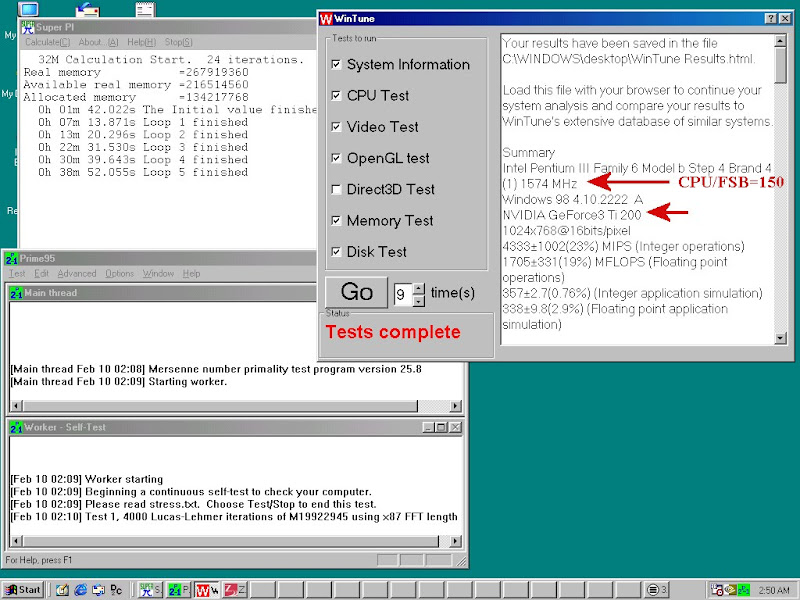I am really interested in this thread. I have set up an Asus P2B rev 1.12 mobo. It uses the i440BX chipset. I have set the bus speed to 133 MHz speed. I am using a 1.4GHz 133FSB Tualatin server chip, in a PowerLeap adapter (revision 2). I've got 2 sticks of 128MB CL2 SDRAM (total 256MB) in it, and I'm using a Voodoo3 2000 AGP VGA. I decided to run these tests in this order
1) I ran SuperPi, and selected the longest test available which was 32M. I ran this test, and let it continue in the background...
2) While SuperPi was running, I ran Prime95 and selected the default test which is called "Blend". I ran this test, and let it continue in the background...
3) While both SuperPi and Prime95 were running, I ran WinTune 98, and set it to run its tests 9 times. I unchecked the Direct 3D test option, because it complains about not finding a Direct 3D device.
4) After WinTune 98 had finished running its 9 tests, I ran WinBench 99. (I did not close WinTune 98.) I selected "custom tests", and choose all of the graphics tests. There were 47 of them.
5) After the 47 WinBench 99 tests had finished, I ran Quake2 (I did not close WinBench 99), and ran the Quake2 demo called timedemo demo1.dm2. I let it run for about 7 minutes. It ran it in 3dfx OpenGL mode, with a resolution of 1024x768. Afterwards, I quit Quake2.
6) I then ran 3DMark 99 Max's default benchmark test twice. Afterwards, I did not close 3DMark 99 Max.
7) I then repeated all tests from 3) to 6) inclusive.
Test start time = 13:39 PM
Test end time = 15:24 PM
Total running time = about 1 hour and 45 minutes.
The overall result: no crashes, no lock ups, and no strange stuff. I remember testing an AOpen AX6BC, and finding it curiously unstable. I think my tests were set to 133 MHz on that board. I do remember getting lock ups. Gerwin, I think the problem is not i440BX + 89MHz AGP = problem, but AOpen AX6BC + 89MHz AGP = problem. I think you need to test a different mobo. The Asus P2Bs are about the best you can get. You even get 3 ISA slots! 😀 I've tested this thing @ 150 FSB, and never had a lock up. I might run those 1-7 tests again, at 150 FSB. Time permitting...
Just one last thing. I find this fascinating, but after running these tests for about 1.75 hours, I could very comfortably rest my fingers on the V3's heatsink (while the tests were still running), and not feel any discomfort. And this particular V3 is the one with the "thin/not tall" heatsink, that weighs 10 grams less than a regular AGP V3. Weird! Having said that, the mobo is not inside a case. Perhaps that makes a huge difference?
Edit: On the mobo, there is a jumper called AGPFS. It is set to 1-2. The other jumper option is 2-3. I haven't got the P2B manual to hand right now. I wonder if this setting is making the AGP port run at a safer speed? It must be some kind of AGP "divider". Does anyone know what this jumper does, for the Asus P2B revision 1.12 mobo? Thanks.
Edit 2: I can answer my own question. I found the relevant information about the AGPFS jumper, from one of my previous posts! I have copied and pasted this info below. It means that the AGP bus is currently operating at a speed of 133 * 2/3 = 89 MHz.
The 3 pin PCIRATIO jumper has been completely "soldered out", meaning that you cannot put jumpers on it.
The 3 pin AGPFS jumper is set to pins 1-2 = "on". The settings for AGPFS are -
1-2 AGPCLK = CPUCLK * 2/3 (Currently Enabled = "on")
2-3 AGPCLK = CPUCLK


